

Fuath. A Fuath (plural Fuathan; Scottish Gaelic pronunciation: [fuə]) is an evil, Gaelic mythological water spirit.
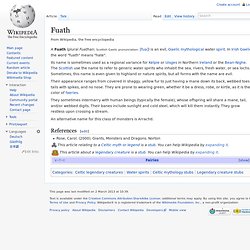
Each-uisge. History[edit] The each-uisge, a supernatural water horse found in the Highlands of Scotland, is supposedly the most dangerous water-dwelling creature in the British Isles.
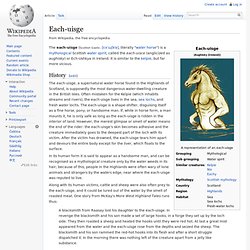
Often mistaken for the Kelpie (which inhabits streams and rivers), the each-uisge lives in the sea, sea lochs, and fresh water lochs. The each-uisge is a shape-shifter, disguising itself as a fine horse, pony, or handsome man. If, while in horse form, a man mounts it, he is only safe as long as the each-uisge is ridden in the interior of land. However, the merest glimpse or smell of water means the end of the rider: the each-uisge's skin becomes adhesive and the creature immediately goes to the deepest part of the loch with its victim. Along with its human victims, cattle and sheep were also often prey to the each-uisge, and it could be lured out of the water by the smell of roasted meat. A blacksmith from Raasay lost his daughter to the each-uisge. See also[edit] References[edit] Dunnie. The Dunnie was also said to wander the crags and dales of the Cheviots singing: "Cockenheugh there's gear enough, Collierheugh there's mair,
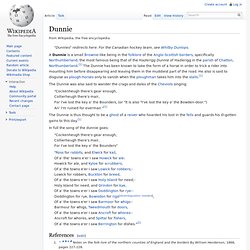
Brownie (folklore) Every manor house had its ùruisg, and in the kitchen, close by the fire was a seat, which was left unoccupied for him.

One house on the banks of the River Tay was even until the beginning of the twentieth century believed to have been haunted by such a sprite, and one room in the house was for centuries called "Seòmar Bhrùnaidh" (Brownie’s room). In 1703, John Brand wrote in his description of Shetland (which he called "Zetland") that: “Not above forty or fifty years ago, every family had a brownie, or evil spirit, so called, which served them, to which they gave a sacrifice for his service; as when they churned their milk, they took a part thereof, and sprinkled every corner of the house with it, for Brownie’s use; likewise, when they brewed, they had a stone which they called ‘Brownie’s stane’, wherein there was a little hole into which they poured some wort for a sacrifice to Brownie. Caoineag. Caoineag (Scottish Gaelic pronunciation: [kʰɯːɲak]) is a Scottish spirit, her name meaning ‘the weeper’ and one of the names given to the Highland Banshee, Caointeach is another.
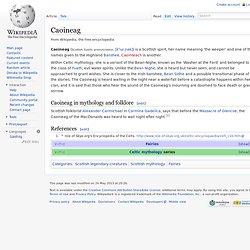
Within Celtic mythology, she is a variant of the Bean-Nighe, known as the 'Washer at the Ford' and belonged to the class of Fuath, evil water spirits. Unlike the Bean Nighe, she is heard but never seen, and cannot be approached to grant wishes. Satyr. The satyrs' chief was Silenus, a minor deity associated (like Hermes and Priapus) with fertility.

These characters can be found in the only complete remaining satyr play, Cyclops, by Euripides, and the fragments of Sophocles' Ichneutae (Tracking Satyrs). The satyr play was a short, lighthearted tailpiece performed after each trilogy of tragedies in Athenian festivals honoring Dionysus. There is not enough evidence to determine whether the satyr play regularly drew on the same myths as those dramatized in the tragedies that preceded. The groundbreaking tragic playwright Aeschylus is said to have been especially loved for his satyr plays, but none of them have survived. Attic painted vases depict mature satyrs as being strongly built with flat noses, large pointed ears, long curly hair, and full beards, with wreaths of vine or ivy circling their balding heads.
Cù Sìth. The Cù-Sìth (Scottish Gaelic pronunciation: [kuː ʃiː]), plural Coin-Sìth (Scottish Gaelic pronunciation: [kɔːn ʃiː]) is a mythological hound found in Scotland and the Hebrides.
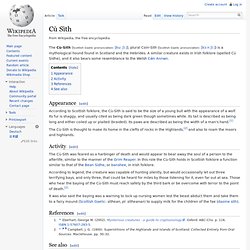
A similar creature exists in Irish folklore (spelled Cú Sídhe), and it also bears some resemblance to the Welsh Cŵn Annwn. Appearance[edit] According to Scottish folklore, the Cù-Sìth is said to be the size of a young bull with the appearance of a wolf. Its fur is shaggy, and usually cited as being dark green though sometimes white. Its tail is described as being long and either coiled up or plaited (braided). Glaistig. The glaistig /ˈɡlæʃtɨɡ/ is a ghost from Scottish mythology, a type of fuath.
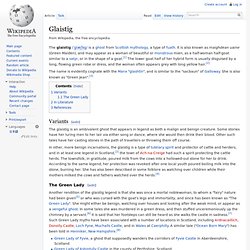
It is also known as maighdean uaine (Green Maiden), and may appear as a woman of beautiful or monstrous mien, as a half-woman half-goat similar to a satyr, or in the shape of a goat.[1] The lower goat half of her hybrid form is usually disguised by a long, flowing green robe or dress, and the woman often appears grey with long yellow hair.[2] The name is evidently cognate with the Manx "glashtin", and is similar to the "sacbaun" of Galloway. She is also known as "Green Jean".[3] Variants[edit] The glaistig is an ambivalent ghost that appears in legend as both a malign and benign creature.
Otherworld. Bodach. A bodach (Scottish Gaelic pronunciation: [ˈpɔt̪əx]; plural bodaich), as borrowed into English, is a mythical spirit or creature, rather like the bogeyman.[1] In Modern Scottish Gaelic the word simply means "old man", colloquially often used affectionately.
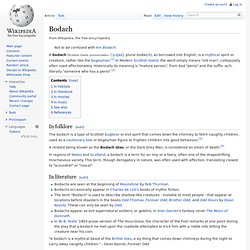
Historically its meaning is "mature person", from bod "penis" and the suffix -ach, literally "someone who has a penis".[2] In folklore[edit] The bodach is a type of Scottish bugbear or evil spirit that comes down the chimney to fetch naughty children, used as a cautionary tale or bogeyman figure to frighten children into good behaviour.[3] Ghillie Dhu. In Scottish folklore the Ghillie Dhu or Gille Dubh is a faerie, a guardian spirit of the trees.
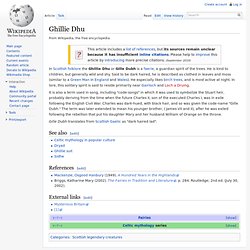
He is kind to children, but generally wild and shy. Said to be dark haired, he is described as clothed in leaves and moss (similar to a Green Man in England and Wales). He especially likes birch trees, and is most active at night. In lore, this solitary spirit is said to reside primarily near Gairloch and Loch a Druing. It is also a term used in song, including "code-songs" in which it was used to symbolize the Stuart heir, probably deriving from the time when the future Charles II, son of the executed Charles I, was in exile following the English Civil War. Púca. The púca (Irish for spirit/ghost), pooka, phouka, phooka, phooca or púka is primarily a creature of Irish folklore.[1] Considered to be bringers both of good and bad fortune, they could either help or hinder rural and marine communities.
The creatures were said to be shape changers which could take the appearance of black horses, goats and rabbits. Etymology[edit] Malevolent or benevolent nature[edit] Cat sìth. The Cat Sìth (Scottish Gaelic: [kʰaht̪ ˈʃiː]) or Cat Sidhe (Irish: [kat̪ˠ ˈʃiː], Cat Sí in new orthography) is a fairy creature from Celtic mythology, said to resemble a large black cat with a white spot on its breast. Hob (folklore) A hob is a type of small mythological household spirit found in the north and midlands of England, but especially on the Anglo-Scottish border, according to traditional folklore of those regions. They could live inside the house or outdoors. They are said to work in farmyards and thus could be helpful, however if offended they could become nuisances. The usual way to dispose of a hob was to give them a set of new clothing, the receiving of which would make the creature leave forever.
It could however be impossible to get rid of the worst hobs.[1] A famous hob called the hobthrust lived near Runswick Bay in a hobhole, and was said to be able to cure whooping cough.[2] Hobgoblin. In John Bunyan's hymn "To be a Pilgrim", the hobgoblin is coupled with "a foul fiend" as two monstrous beings who try but fail to "daunt the Pilgrim's spirit". The term "hobgoblin" has grown to mean a superficial object that is a source of (often imagined) fear or trouble. Probably the best-known example of this usage is Ralph Waldo Emerson's line, "A foolish consistency is the hobgoblin of little minds," from the essay Self-Reliance.[2] Hobgoblins in modern fantasy fiction[edit] The Spiderwick Chronicles[edit] Fairy. Aos Sí. Some secondary and tertiary sources including well-known and influential authors such as W.B. Yeats refer to aos sí simply as "the sídhe" (lit.: mounds).[1]
Sylph. Changeling. A changeling is a creature found in folklore and folk religion. A changeling child was believed to be a fairy child that had been left in place of a human child stolen by the fairies. The theme of the swapped child is common in medieval literature and reflects concern over infants thought to be afflicted with unexplained diseases, disorders, or developmental disabilities. Description[edit] Draugr. "Sea-troll" of modern Scandinavian folklore as depicted by the Norwegian painter Theodor Kittelsen The draugr or draug (Old Norse: draugr, plural draugar; modern Icelandic: draugur, Faroese: dreygur and Norwegian, Swedish and Danish draugen), also called aptrganga, literally "again-walker" (Icelandic: afturganga) is an undead creature from Norse mythology, a subset of Germanic mythology.